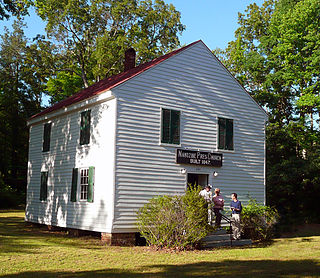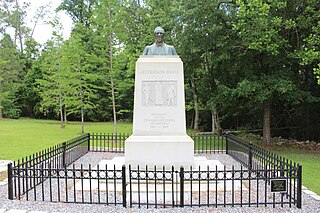
The Army of Northern Virginia was the primary military force of the Confederate States of America in the Eastern Theater of the American Civil War. It was also the primary command structure of the Department of Northern Virginia. It was most often arrayed against the Union Army of the Potomac.

The Richmond–Petersburg campaign was a series of battles around Petersburg, Virginia, fought from June 9, 1864, to March 25, 1865, during the American Civil War. Although it is more popularly known as the siege of Petersburg, it was not a classic military siege, in which a city is encircled with fortifications blocking all routes of ingress and egress, nor was it strictly limited to actions against Petersburg. The campaign consisted of nine months of trench warfare in which Union forces commanded by Lt. Gen. Ulysses S. Grant assaulted Petersburg unsuccessfully and then constructed trench lines that eventually extended over 30 miles (48 km) from the eastern outskirts of Richmond, Virginia, to around the eastern and southern outskirts of Petersburg. Petersburg was crucial to the supply of Confederate Gen. Robert E. Lee's army and the Confederate capital of Richmond. Numerous raids were conducted and battles fought in attempts to cut off the Richmond and Petersburg Railroad. Many of these battles caused the lengthening of the trench lines.

George Stoneman Jr. was a United States Army cavalry officer and politician who served as the fifteenth Governor of California from 1883 to 1887.

The Battle of Appomattox Court House, fought in Appomattox County, Virginia, on the morning of April 9, 1865, was one of the last battles of the American Civil War (1861–1865). It was the final engagement of Confederate General in Chief Robert E. Lee and his Army of Northern Virginia before they surrendered to the Union Army of the Potomac under the Commanding General of the United States Army, Ulysses S. Grant.

Wesley Merritt was an American major general who served in the cavalry of the United States Army during the American Civil War, American Indian Wars, and Spanish–American War. Following the latter war, he became the first American Military Governor of the Philippines.

The Battle of Sailor's Creek was fought on April 6, 1865, near Farmville, Virginia, as part of the Appomattox Campaign, near the end of the American Civil War. It was the last major engagement between the Confederate Army of Northern Virginia, commanded by General Robert E. Lee, and the Army of the Potomac, under the overall direction of Union General-in-Chief Lieutenant General Ulysses S. Grant.

The Appomattox campaign was a series of American Civil War battles fought March 29 – April 9, 1865, in Virginia that concluded with the surrender of Confederate General Robert E. Lee's Army of Northern Virginia to forces of the Union Army under the overall command of Lieutenant General Ulysses S. Grant, marking the effective end of the war.

The Battle of Cove Mountain occurred in Wythe County, Virginia, on May 10, 1864, during the American Civil War. A Union cavalry division commanded by Brigadier General William W. Averell was prevented from attacking a lead mine located near Wytheville. Confederate forces commanded by Brigadier General John Hunt Morgan, with a detachment of a brigade of cavalry from the command of Brigadier General William E. "Grumble" Jones, stopped Averell at Cove Gap, adjacent to Crockett's Cove and Cove Mountain.

The Battle of Namozine Church was an engagement in Amelia County, Virginia, between Union Army and Confederate States Army forces that occurred on April 3, 1865, during the Appomattox Campaign of the American Civil War. The battle was the first engagement between units of General Robert E. Lee's Confederate Army of Northern Virginia after that army's evacuation of Petersburg and Richmond, Virginia, on April 2, 1865, and units of the Union Army under the immediate command of Maj. Gen. Philip Sheridan, who was still acting independently as commander of the Army of the Shenandoah, and under the overall direction of Union General-in-Chief Lt. Gen. Ulysses S. Grant. The forces immediately engaged in the battle were brigades of the cavalry division of Union Brig. Gen. and Brevet Maj. Gen. George Armstrong Custer, especially the brigade of Colonel and Brevet Brig. Gen. William Wells, and the Confederate rear guard cavalry brigades of Brig. Gen. William P. Roberts and Brig. Gen. Rufus Barringer and later in the engagement, Confederate infantry from the division of Maj. Gen. Bushrod Johnson.

William Nelson Pendleton was an American teacher, Episcopal priest, and soldier. He served as a Confederate general during the American Civil War, noted for his position as Gen. Robert E. Lee's chief of artillery for most of the conflict. After the war, Pendleton returned to his priestly duties and also wrote religious materials. Camp Pendleton in Virginia Beach, Virginia, is named in his honor.

The Carolinas campaign, also known as the campaign of the Carolinas, was the final campaign conducted by the Union Army against the Confederate Army in the Western Theater of the American Civil War. On January 1, Union Maj. Gen. William T. Sherman advanced north from Savannah, Georgia, through the Carolinas, with the intention of linking up with Union forces in Virginia. The campaign culminated in the defeat of Confederate Gen. Joseph E. Johnston's army at the Battle of Bentonville, and its unconditional surrender to Union forces on April 26, 1865. Coming just two weeks after the defeat of Robert E. Lee's army at the Battle of Appomattox Court House, it signaled that the war was effectively over.

The 15th Pennsylvania Cavalry Regiment, known as the Anderson Cavalry and the 160th Volunteers, was a three-year cavalry regiment in the Union Army during the American Civil War. It was recruited and formed in the summer of 1862 by officers and men of the Anderson Troop, an independent company of the Pennsylvania Volunteers that had been mustered the previous November.
The Battle of Appomattox Station was fought between a Union Army cavalry division under the command of Brigadier General George Armstrong Custer and Confederate Army of Northern Virginia artillery units commanded by Brigadier General Lindsay Walker with support from some dismounted cavalrymen, artillerymen armed with muskets and some stragglers on April 8, 1865, at Appomattox Station, Virginia during the Appomattox Campaign of the American Civil War.

James Dearing was a Confederate States Army officer during the American Civil War who served in the artillery and cavalry. Dearing entered West Point in 1858 and resigned on April 22, 1861, when Virginia seceded from the Union. Dearing was mortally wounded at the Battle of High Bridge during the Appomattox Campaign of 1865, making him one of the last officers to die in the war. Despite serving as a commander of a cavalry brigade and using the grade of brigadier general after he was nominated to that grade by Confederate President Jefferson Davis, Dearing did not officially achieve the grade of brigadier general because the Confederate Senate did not approve his nomination. His actual permanent grade was colonel.
The Battle of Amelia Springs, Virginia was an engagement between the Union Army and Confederate Army of Northern Virginia that occurred on April 5, 1865 during the Appomattox Campaign of the American Civil War. It was followed by a second rear guard action near the same location on the night of April 5, 1865 and morning of April 6, 1865 during the Union Army pursuit of the Confederate forces which were fleeing westward after the fall of Petersburg and Richmond, Virginia at the Third Battle of Petersburg on April 2, 1865. The actions took place just prior to the Battle of Sailor's Creek on April 6, 1865. That battle would be the last major engagement between the Union Army under the overall direction of Union General-in-Chief, Lt. Gen. Ulysses S. Grant, and General Robert E. Lee's Army of Northern Virginia before that Confederate army's surrender at Appomattox Court House, Virginia on April 9, 1865.

Mississippi was the second southern state to declare its secession from the United States, doing so on January 9, 1861. It joined with six other southern states to form the Confederacy on February 4, 1861. Mississippi's location along the lengthy Mississippi River made it strategically important to both the Union and the Confederacy; dozens of battles were fought in the state as armies repeatedly clashed near key towns and transportation nodes.
Ebenezer Creek is a tributary of the Savannah River in Effingham County, Georgia, about 20 miles north of the city of Savannah. During the American Civil War, an incident at the creek resulted in the drowning of many freed slaves.

The Battle of Marion was a military engagement fought between units of the Union Army and the Confederate Army during the American Civil War near the town of Marion, Virginia. The battle was part of Union Maj. Gen. George Stoneman's attack upon southwest Virginia, aimed at destroying Confederate industrial infrastructure near Saltville and Marion. Union Cavalry and Infantry regiments—some 4,500 soldiers in total—left Tennessee on December 17 for southwestern Virginia.

Jefferson Davis Memorial Historic Site is a 12.668-acre (5.127 ha) state historic site located in Irwin County, Georgia that marks the spot where Confederate States President Jefferson Davis was captured by United States Cavalry on Wednesday, May 10, 1865. The historic site features a granite monument with a bronze bust of Davis that is located at the place of capture. The memorial museum, built in 1939 by the Works Progress Administration, features Civil War era weapons, uniforms, artifacts and an exhibit about the president's 1865 flight from Richmond, Virginia to Irwin County, Georgia.

The 1st Virginia Cavalry Regiment was a cavalry regiment raised in Virginia for service in the Confederate States Army during the American Civil War. It fought mostly with the Army of Northern Virginia.

















